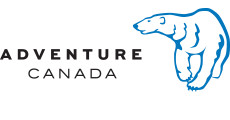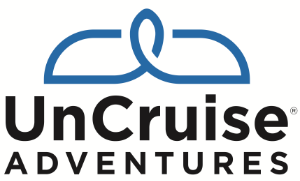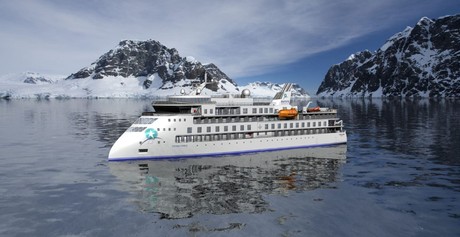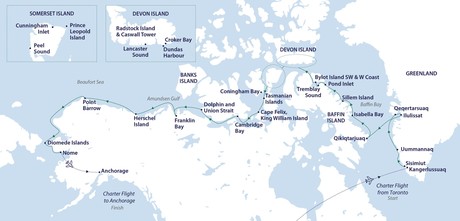Complete Northwest Passage from Toronto to Anchorage
On this epic voyage inspired by Roald Amundsen’s historic expedition, we attempt to sail the full length of the Northwest Passage, carving our way west through the labyrinthine maze of waterways that hug the fabled islands of Arctic Canada until we reach the Beaufort Sea. Building on our classic Northwest Passage voyage, we visit historical sites explored by heroic explorers, meet the incredible folk that call this region home, and search for enigmatic wildlife found in this unique corner of the world. Pack ice may halt our voyage through the passage, so brace yourself for a genuine expedition where adventure awaits at every turn.
Highlights
• Stand in awe of Ilulissat Icefjord, a UNESCO World Heritage Site
• Hike on Devon Island, the world’s largest uninhabited island, which features stunning geology, fjords and glacial valleys to explore
• On Beechey Island, visit memorials and graves of explorers from John Franklin’s expedition
• Keep watch with the hope of spotting iconic Arctic wildlife including musk ox, polar bears, beluga whales, walrus and perhaps narwhal
Having made your way to Toronto Airport, check-in at Westin Toronto Airport Hotel for an overnight stay. At our welcome briefing this evening, enjoy a drink and meet fellow expeditioners. A representative from Aurora Expeditions will provide you with important information about biosecurity and also about the charter flight to Kangerlussuaq tomorrow. You will receive Aurora Expeditions cabin tags for your luggage. Please clearly label the tags with your name and ship cabin number. Accommodation: Westin Toronto Airport Hotel (or similar)
After breakfast at the hotel, board our charter flight to Kangerlussuaq, Greenland, where our vessel Sylvia Earle awaits. After boarding, there is time to settle into your cabin before our important safety briefings. The sailling out of Søndre Strømfjord, with its towering mountains on both sides, is magnificent. This evening, meet your expedition team and crew at the Captain’s Welcome Dinner.
Greenland’s second largest town, Sisimiut is located approximately 54 kilometres (33.5 miles) north of the Arctic Circle, meaning that during summer, you can experience the midnight sun here. The town is famous for the old blue church with the gate made of whale bone. In the cosy museum next door to the church, you will find an excellent reconstruction of an Inuit turf house as well as exhibits of local history and early life in Greenland. Sisimiut offers hiking trails with various degrees of difficulty. The easier trails take you through the town itself, its outskirts and into the mountains, where you will find spectacular vantage points. Approximately 4,500 years ago, the Saqqaq culture arrived from Canada and settled in the area. They lived here for approximately 2,000 years, after which they mysteriously disappeared from the area. The Dorset culture arrived around 500 CE and stayed until the 1200s until they were replaced by the Thule culture, and today, the majority of the population of Sisimiut are descendants of the Thule culture.
Known as the ‘birthplace of icebergs’, this region produces some of the most dazzling icebergs found anywhere in the Arctic. Hike past the husky sledge dogs to the UNESCO World Heritage-listed Icefjord and stand in awe of its immensity. Sermeq Kujalleq, also known as Jakobshavn Glacier, is the most productive glacier – not only in Greenland but the entire Northern Hemisphere. It produces 20 million tonnes of ice each day, all floating into the Ilulissat Icefjord and Disko Bay. Conditions permitting, enjoy a Zodiac cruise at the mouth of the fjord and kayak through sea ice and icebergs. An optional 90-minute helicopter flight over the icefjord is a truly once-in-a-lifetime experience. Optional helicopter flight (90 mins): this excursion is the only way you can get close to the gigantic glacier. The 12-seater helicopter departs from Ilulissat Airport and sweeps over hills, lakes and ice fjords. Land on the mountain at Kangia, in the middle of the preserved area, where you can revel in the incredible surroundings. On the return flight to Ilulissat, fly above the edge of the glacier with breathtaking views of the massive icebergs drifting in the fjord. The views of some of the largest icebergs that become stranded on a moraine underneath the water, just outside the town, offers a wonderful finale to this excursion. (Additional charge applies). Please note this excursion requires a minimum of 8 people to operate.
This compelling island seems to have more in common with Iceland than Greenland. While most of the interior is mountainous and glaciated, its beautiful shorelines boast black sandy beaches, unusual basalt columns, hot springs and dramatic lava formations. On a guided hike, enjoy a diversity of Arctic flora. Zodiac cruise in Disko Bay, a hotspot for marine life including humpback, fin, minke and bowhead whales. The small friendly village has a fascinating historical museum.
Our team of experts entertain us with informative talks about wildlife, geology and epic tales of early explorers such as Franklin and Amundsen. As we cross Baffin Bay, keep watch for various species of whale and some of Greenland’s famous icebergs.
The east coast of Baffin Island features hidden bays that are feeding grounds for bowhead whales and where glaciers calve into the sea. Sail along inlets and fjords surrounded by towering mountains that feature impressive geology. Conditions permitting, we hope to go ashore at Pond Inlet-Mittimatalik and be treated to a warm welcome from the local community.
At a latitude of almost 75° degrees north, we are now truly in the High Arctic. Lancaster Sound - located between Devon Island and Baffin Island - forms the eastern entrance to the Northwest Passage. It also forms part of the newly formed Tallurutiup Imanga National Marine Conservation Area, where nutrient-rich waters support an abundance of wildlife.
Devon Island is the largest uninhabited island on Earth and features stunning geology, with flat-topped mountains and glacial valleys giving it its unique character. We hope to visit Dundas Harbour to enjoy offers walks on undulating tundra, and perhaps some birdwatching. A dilapidated Royal Canadian Mounted Police outpost and remnants of a Hudson’s Bay Company trading post can be found here. Other possible places that we might visit include Croker Bay and Maxwell Bay.
At the western end of Devon Island lies Beechey Island, where we plan to land. Named after Frederick William Beechey, the island is one of Canada’s most important arctic sites and is a designated Canadian National Historic Site. During the Franklin expedition of 1845–46, Franklin attempted to sail through the Northwest Passage with HMS Erebus and HMS Terror, with perilous results – three of his men are buried here. Roald Amundsen landed at Beechey Island in 1903, during the first successful voyage by ship to fully transit the Northwest Passage from the Atlantic Ocean to the Pacific Ocean.
Note: In true expeditionary style, our itinerary for the following days is heavily dependent on unpredictable sea ice and weather conditions. The following places are where we hope to visit.
Prince Leopold Island, Port Leopold
On the southern side of Lancaster Sound opposite Beechey Island lie the towering bird cliffs of Prince Leopold Island— the most important bird sanctuary in the Canadian Arctic, with approximately 500,000 birds nesting pairs here in summer.
Nearby Port Leopold is a historic site where British explorer James Clark Ross wintered in 1848 while searching for the missing Franklin expedition. The ruin of a century old Hudson’s Bay trading post can be found there, and ringed seals are sometime spotted on ice floes within the bay.
Cunningham Inlet
On the north coast of Somerset Island, the local scenery makes for excellent guided walks, where waterway trails lead to waterfalls and higher ground.
Bellot Strait
A deep and windy waterway bordered by steep slopes, Bellot Strait is characterised by strong, swirling, tidal currents that require navigation to be undertaken close to times of slack water (four times a day). Point Zenith, the most northern continental point of the Americas is located in the strait.
Note: Due to swirling currents up to 10 knots, Bellot Strait is better transited during eastbound voyages because if it is blocked, there is the alternative to continue north through Peel Sound. On a westbound voyage, it would be necessary to make a long detour back north through Prince Regent Inlet.
Coningham Bay
Across from Victoria Strait, Coningham Bay lies on the shores of Prince of Wales Island. This is a polar bear hotspot where the majestic creatures come to feast on beluga whales who enter the bay each summer to shed their skin on shallow sandy banks. It is not unusual to find the shoreline littered with whale skeletons – and very healthy-looking polar bears!
King William Island
Remains attributed to the Franklin expedition have been found at 35 different locations on King William Island and on nearby Adelaide Peninsula. South of Cape Felix, in Victoria Strait, we hope to get close to where the HMS Erebus and HMS Terror were abandoned in 1848.
Your experienced expedition team will create your day-by-day itineraries based on sea ice and weather conditions. We hope to meet the resilient locals who make the extreme far north their home.
In our Zodiacs, we plan to explore the coastlines, bays and hidden estuaries of the region, and delight in the show of autumn colours during this season of change. Where it’s possible to land, we stretch our legs on hikes to explore the dramatic landscapes of hills, valleys, cliffs and canyons of the region.
Below are some of the places in the area that we may visit:
Cambridge Bay- Iqaluktuuttiaq
The administrative and transportation hub of the region, Cambridge Bay- Iqaluktuuttiaq is the largest stop for passenger and research vessels traversing the Northwest Passage and unofficially marks the midpoint for voyages of the Northwest Passage. Zodiac ashore for an exploration of this Inuit settlement located in the high arctic. Enjoy a walk through the village, where you can visit the local church, visitor centre and support the local community by purchasing some locally made handicrafts.
Edinburgh Island
Edinburgh Island is a small and uninhabited island in Canada’s Nunavut region. The scenery consists of colourful flowering shrubs, beaches tinged in stunning ochres, while the surrounding cliffs shaded in rich, deep tones. A possible walk to a lookout offers spectacular views over surrounding lakes, sea and mountains.
Johansen Bay
At Victoria Island, we hope to enjoy a Zodiac excursion within an estuary of at the northeast end of Johansen Bay and up the river towards the lake.
Port Epworth/Tree River
The Tree River area on the mainland – also known a Port Epworth – provides a spectacular backdrop our possible exploration, with its river and shallow lakes, striking sedimentary rock outcrops and bright autumnal colours of tundra.
Smoking Hills, Franklin Bay
The Smoking Hills in Canada’s Northwest Territories have been smouldering, sending plumes of gas across the landscape, for centuries. Technically sea cliffs, you would be forgiven for thinking that the multicoloured fiery natural phenomenon is the set to an apocalyptic movie depicting the end of the world. The smoke is caused by layers of combustible, sulphur-rich lignite (brown coal) that ignites and emit sulphurous gas into the air, when exposed to erosion and landslides, which also creates a dazzling colouration of the rocks.
Excitement builds as we sail the Beaufort Sea. Whether you are out on deck or in the comfort of one the observation lounges, watch as the captain navigates our state-of-the-art vessel through these waterways, which is frozen for most of the year.
We farewell Canada and enter the United States.
As we sail westwards to Nome, along the northern coast of Alaska to where the USA and Russia are only 100 km (60 miles) apart, separated by the Bering Sea, there is ample time to reflect on our adventures while scanning the water for marine life. Share, edit and submit pictures in our photo competition and attend final lectures from our team of onboard experts. We hope to get permission to ship cruise close by Little Diomede and King islands in Alaska.
In Nome, farewell your expedition team and crew after sharing a once-in-a-lifetime voyage together. After disembarking, we transfer to the airport for your charter flight to Anchorage for an overnight stay.
Accommodation: Hilton Hotel Anchorage (or similar)
Transfer to the airport for your onward journey. Please note that this is an indicative itinerary only and is subject to change. Sea ice and weather conditions determine our route, and Aurora Expeditions cannot guarantee the complete crossing of the Northwest Passage to the Beaufort Sea. However, we will certainly have an incredible adventure trying!
In true expedition style we encourage exploration and adventure, offering flexibility in challenging environments in a way that puts you among the action to see and do as much as possible. This itinerary is only a guide and subject to change due to ice and weather conditions.
|
Book now |
Aurora Stateroom Triple Share

Aurora Stateroom Superior

Balcony Stateroom Category B

Balcony Stateroom Category A

Balcony Stateroom Superior

Balcony Stateroom Category C
Junior Suite
Captain’s Suite
Vessel Type: Luxury Expedition
Length: 104 meters
Passenger Capacity: 126
Built / Refurbished: 2020/2021
Due to sail in October 2021 our new ship honours the highly accomplished marine biologist, oceanographer and explorer, Sylvia Earle. As the first female chief scientist of the U.S. National Oceanic and Atmospheric Administration, and named by Time Magazine as its first Hero for the Planet in 1998 – this vessel pays tribute to Sylvia’s long standing conservation efforts for marine protected areas and ocean wildlife. Sylvia Earle will be actively involved in the development of her namesake.
Designed for rugged, remote areas Crossing the notorious Drake Passage or the Denmark Strait, our expeditions face some of the most intense conditions nature can throw at us. The Sylvia Earle is at the cutting edge of nautical technology: robust, powerful and up to the task.
Ulstein X-BOW® & Lounge The streamlined Ulstein X-BOW® cuts through the swell so you feel fewer vibrations and disturbances*, and makes quicker transits through waves. It also helps reduce our fuel consumption by up to 60%^. Experience the Glass Atrium Lounge inside the bow, featuring huge windows and superb views to the front of the ship.
Swimming pool & wellness centre In between landings, enjoy the heated saltwater open air swimming pool and jacuzzis on board the Sylvia Earle and watch the world go by, or experience our gym, sauna or enjoy a massage (additional cost) in the Wellness centre.
Safety features The Sylvia Earle will feature industry-leading safety technology that exceeds the requirements for a ship of this size with a world class return-to-port equipment, which duplicates the propulsion system, enabling the ship to maintain operating systems and comfort in the event of engine failure. The ship will also feature a fully-stocked medical clinic designed for use in remote areas.
Responsible travel features We believe that preserving and protecting the environment is of the utmost importance and this is reflected in several features of the Sylvia Earle. The Sylvia Earle will boast one of the lowest polluting marine engines in the world due to low energy consumption, high fuel-efficiency and a streamlined design to deliver an 80% reduction in emissions. The ship can also utilise virtual anchoring to hold its position using a combination of GPS, steering technology, propellers and thrusters. This protects the sea floor and minimises the damage caused by conventional anchors.
Zodiac launching platforms Our ships carry many Zodiacs, which you can board via four dedicated, sea-level launching platforms. These platforms make boarding the Zodiacs as quick, efficient and safe as possible, minimising wait times and getting you closer to the action for longer. Whether you’re Zodiac cruising through awe-inspiring fjords in search of wildlife or making a quick transit from ship to a shore landing site, these sturdy crafts will play an integral role in your expedition experience.
Activity preparation area We offer a range of add-on adventure activities from kayaking and diving to climbing and ski touring, and your ship is designed to support these activities, making the transition from ship to sea or shore as smooth as possible. We built the spacious activity preparation areas and loading platforms in consultation with our expert activity guides. You will also have access to lockers and rapid drying areas for dry suits and wet suits, to give your gear the best chance to dry between excursions.









Sea Kayaking
Sea Kayaking One of the most exhilarating ways to experience Antarctica, the Arctic and beyond.
Inclusions
• Accommodation in your chosen stateroom or suite
• All Zodiac excursions
• Shore excursions specified as included in the itinerary
• Entrance fees where applicable
• Experienced expedition team
• On board lectures held by expedition team
• All meals while on board
• House wines, beer and soft drinks included with dinner
• Captain’s Welcome and Farewell drinks including four-course dinner, house cocktail, house beer and wine, non-alcoholic beverages
• Rubber boots for use during the voyage
• Complimentary access to our onboard doctor for consultations relating to sea-sickness
• Comprehensive pre-departure material
• Personalised voyage photo book (post-voyage)
• Port fees/taxes
• Suite Benefits - Additional benefits for those who book Balcony, Junior and Captain's Suites:
• One free pair of binoculars per suite
• 1-hour spa treatment (Massage or facial only)
• Free stocked mini bar (Balcony and Junior suites stocked once, not replenished. Captains suite replenished as needed)
• Gratuities/tips for crew included - to the value of USD$15 per person per day~
• 1 free bottle of champagne per suite
• All airport transfers mentioned in the itinerary.
• One night’s hotel accommodation including breakfast, in Toronto on Day 1.
• Charter flight from Toronto to Kangerlussuaq on Day 2.
• Flight (group allocation) from Nome to Anchorage on Day 29.
Exclusions
• International or domestic airfares unless specified in the itinerary
• Pre and post voyage accommodation
• Transfers
• Beverages other than those listed in inclusions
• Gratuities
• Any items of a personal nature including medical costs incurred on board
• Passport and visa costs if applicable
• Travel insurance including mandatory medical evacuation cover
• GRATUITIES. A US$15.00 per person per day gratuity for the crew is automatically added to your onboard account. It is at your discretion if you would like to remove the tip (or increase/decrease the amount) when you settle your account. It is not necessary to tip the expedition team members.
Our Associates Include







